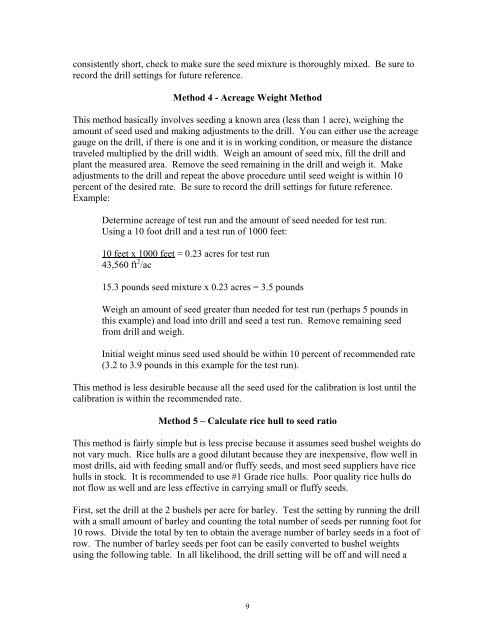TECHNICAL NOTE - Plant Materials Program
TECHNICAL NOTE - Plant Materials Program
TECHNICAL NOTE - Plant Materials Program
You also want an ePaper? Increase the reach of your titles
YUMPU automatically turns print PDFs into web optimized ePapers that Google loves.
consistently short, check to make sure the seed mixture is thoroughly mixed. Be sure to<br />
record the drill settings for future reference.<br />
Method 4 - Acreage Weight Method<br />
This method basically involves seeding a known area (less than 1 acre), weighing the<br />
amount of seed used and making adjustments to the drill. You can either use the acreage<br />
gauge on the drill, if there is one and it is in working condition, or measure the distance<br />
traveled multiplied by the drill width. Weigh an amount of seed mix, fill the drill and<br />
plant the measured area. Remove the seed remaining in the drill and weigh it. Make<br />
adjustments to the drill and repeat the above procedure until seed weight is within 10<br />
percent of the desired rate. Be sure to record the drill settings for future reference.<br />
Example:<br />
Determine acreage of test run and the amount of seed needed for test run.<br />
Using a 10 foot drill and a test run of 1000 feet:<br />
10 feet x 1000 feet = 0.23 acres for test run<br />
43,560 ft 2 /ac<br />
15.3 pounds seed mixture x 0.23 acres = 3.5 pounds<br />
Weigh an amount of seed greater than needed for test run (perhaps 5 pounds in<br />
this example) and load into drill and seed a test run. Remove remaining seed<br />
from drill and weigh.<br />
Initial weight minus seed used should be within 10 percent of recommended rate<br />
(3.2 to 3.9 pounds in this example for the test run).<br />
This method is less desirable because all the seed used for the calibration is lost until the<br />
calibration is within the recommended rate.<br />
Method 5 – Calculate rice hull to seed ratio<br />
This method is fairly simple but is less precise because it assumes seed bushel weights do<br />
not vary much. Rice hulls are a good dilutant because they are inexpensive, flow well in<br />
most drills, aid with feeding small and/or fluffy seeds, and most seed suppliers have rice<br />
hulls in stock. It is recommended to use #1 Grade rice hulls. Poor quality rice hulls do<br />
not flow as well and are less effective in carrying small or fluffy seeds.<br />
First, set the drill at the 2 bushels per acre for barley. Test the setting by running the drill<br />
with a small amount of barley and counting the total number of seeds per running foot for<br />
10 rows. Divide the total by ten to obtain the average number of barley seeds in a foot of<br />
row. The number of barley seeds per foot can be easily converted to bushel weights<br />
using the following table. In all likelihood, the drill setting will be off and will need a<br />
9

















